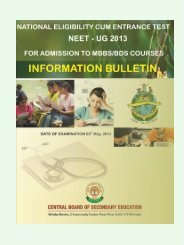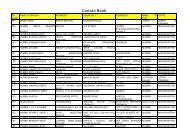Examination Syllabus - NEET-UG, 2013
Examination Syllabus - NEET-UG, 2013
Examination Syllabus - NEET-UG, 2013
Create successful ePaper yourself
Turn your PDF publications into a flip-book with our unique Google optimized e-Paper software.
UNIT I: Some Basic Concepts of Chemistry<br />
CHEMISTRY<br />
CONTENTS OF CLASS XI SYLLABUS<br />
General Introduction: Important and scope of chemistry.<br />
Laws of chemical combination, Dalton’s atomic theory: concept of elements, atoms and molecules.<br />
Atomic and molecular masses. Mole concept and molar mass; percentage composition and empirical and molecular<br />
formula; chemical reactions, stoichiometry and calculations based on stoichiometry.<br />
UNIT II: Structure of Atom<br />
Atomic number, isotopes and isobars. Concept of shells and subshells, dual nature of matter and light, de Broglie’s<br />
relationship, Heisenberg uncertainty principle, concept of orbital, quantum numbers, shapes of s,p and d orbitals, rules for<br />
filling electrons in orbitals- Aufbau principle, Pauli exclusion principles and Hund’s rule, electronic configuration of atoms,<br />
stability of half filled and completely filled orbitals.<br />
UNIT III: Classification of Elements and Periodicity in Properties<br />
Modern periodic law and long form of periodic table, periodic trends in properties of elements- atomic radii, ionic radii,<br />
ionization enthalpy, electron gain enthalpy, electronegativity, valence.<br />
UNIT IV: Chemical Bonding and Molecular Structure<br />
Valence electrons, ionic bond, covalent bond, bond parameters, Lewis structure, polar character of covalent bond, valence<br />
bond theory, resonance, geometry of molecules, VSEPR theory, concept of hybridization involving s, p and d orbitals and<br />
shapes of some simple molecules, molecular orbital theory of homonuclear diatomic molecules (qualitative idea only).<br />
Hydrogen bond.<br />
UNITV: States of Matter: Gases and Liquids<br />
Three states of matter, intermolecular interactions, types of bonding, melting and boiling points, role of gas laws of<br />
elucidating the concept of the molecule, Boyle’s law, Charle’s law, Gay Lussac’s law, Avogadro’s law, ideal behaviour of<br />
gases, empirical derivation of gas equation. Avogadro number, ideal gas equation. Kinetic energy and molecular speeds<br />
(elementary idea), deviation from ideal behaviour, liquefaction of gases, critical temperature.<br />
Liquid State- Vapour pressure, viscosity and surface tension (qualitative idea only, no mathematical derivations).<br />
UNITVI : Thermodynamics<br />
First law of thermodynamics-internal energy and enthalpy, heat capacity and specific heat, measurement of U and H,<br />
Hess’s law of constant heat summation, enthalpy of : bond dissociation, combustion, formation, atomization, sublimation,<br />
phase transition, ionization, solution and dilution.<br />
Introduction of entropy as state function, Second law of thermodynamics, Gibbs energy change for spontaneous and nonspontaneous<br />
process, criteria for equilibrium and spontaneity.<br />
Third law of thermodynamics- Brief introduction.<br />
UNIT VII: Equilibrium<br />
Equilibrium in physical and chemical processes, dynamic nature of equilibrium, law of chemical equilibrium, equilibrium<br />
constant, factors affecting equilibrium-Le Chatelier’s principle; ionic equilibrium- ionization of acids and bases, strong and<br />
weak electrolytes, degree of ionization, ionization of polybasic acids, acid strength, concept of pH., Hydrolysis of salts<br />
(elementary idea)., buffer solutions, Henderson equation, solubility product, common ion effect (with illustrative examples).





